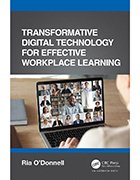How to approach learning technologies in the workplace
The COVID-19 pandemic has prompted many companies to modernize their operations, whether it’s using AI to automate processes or replacing outdated tools with cloud-based services. These changes in the workplace also meant that employees had to learn new skills. It is becoming increasingly important for companies to offer work-based learning and professional development to provide new skills and retain employees.
In the book Transformative digital technology for effective workplace learning, Author Ria O’Donnell provides an in-depth look at how workplace learning has evolved due to factors such as the pandemic, the Rise of the gig economy and new technologies. It also provides insights into how organizations can use digital technologies to teach employees new skills and measure the effectiveness of workplace learning.
In this interview, O’Donnell discussed how companies can address the integration of digital learning technologies in the workplace and address the challenges companies face when implementing new learning technologies.
Editor’s note: This interview has been edited for length and clarity.
The COVID-19 pandemic has accelerated many industries by five to ten years. Have you seen this effect in how people learn and how organizations encourage professional development?
Ria O’Donnell: 100% because people have to learn new roles and new ways of working, because they’re decentralized and they have to take on responsibilities that they didn’t have to take on before. Some people are thrown in front of computers who haven’t necessarily used computers and are forced to learn new things.
At the same time, they have to learn it in ways they may not be familiar with, using technology. They might have been at work before and completed a class where an instructor taught them the new skills, whereas now everyone has just been thrown in at the deep end and they have to learn how to use new technologies to learn skills.
For companies adopting new learning technologies in the workplace such as augmented reality (AR) and virtual reality (VR), AI and Experience APIshow do you recommend them to determine which is the best option for their employees?
 Ria O’Donnell
Ria O’Donnell
O’Donnell: I think it’s probably worth it for many companies to outsource professionals or bring in in-house professionals who are capable in their role of assessing the entire landscape. They are able to look at the overall learning and development framework across the organization and say, “These are the things that employees or contributors need; these are the tools that would help them; these are the resources we have.’
You can do it like an audit of what organizations have and what skills gaps they need to fill. They can make recommendations as to whether the company needs to invest in AR and VR or in AI. You can also look at the type of learning analytics in place and next steps to address personalizing learning and creating opportunities for people who may be a little above or a little below the mainstream.
One challenge your book discusses is the lack of standards for implementing and measuring the effectiveness of newer technologies like AR and VR. How can companies leverage newer technologies for their workplace learning initiatives?
O’Donnell: If you look at it from a smaller perspective and look at an individual organization, if they’re going to develop what they believe to be their own framework and standards, what would they need to be able to benchmark where the people are? You can specify what you need and which way you want people to see you. They can develop their own mini standards and compare themselves to them while waiting for the rest of the technology to catch up.
Some employees may be reluctant to use technology such as a VR headset in a learning scenario. How can companies integrate new technologies in a way that encourages employees to use them?
 Click here to learn more about it
Click here to learn more about itTransformational digital
Technology for Effective
learning at work.
O’Donnell: It’s a two-pronged issue, because you’re teaching people new skills, but you’re also teaching them how to learn those skills. When teaching someone, how do you use a VR headset and interact with that type of technology, which means a steep learning curve? Trying to involve people is a cultural shift where it becomes part of what they do every day.
It’s not going to be something that’s separate where you go off to take a course and it’s like an opportunity that you get once a year. It becomes something that people do every day, and they share their new knowledge with others, and it’s all built into their KPIs or their team goals. It becomes part of the daily routine to have this expectation of continuous learning and development.
How do you see the further advances of learning technologies in the workplace?
O’Donnell: There are opportunities for startups and companies in education technology because it’s something that’s – literally – taking over the whole world where everyone needs to learn. It used to be limited to schooling, and now everyone has to study constantly.
These education technology startups have a tremendous opportunity as there are now fewer barriers to entry because there is a lot of sharing. Everything is in the cloud. People are capable of testing things, and there are many organizations willing to be tested. A lot is being invested in this area as well. It’s just a huge marketplace that really needs some technology to fill in the gaps. For people who want to develop virtual reality simulations or AI skills, they really have a huge opportunity.
What is the most important thing for the readers of your book?
O’Donnell: I think the most important takeaway from this book is the way technology advances at such an accelerated pace that things will never slow down or go backwards. We all need to make an effort to try new digital technologies and to engage and immerse ourselves in these technologies instead of falling back to old, convenient ways. Because as we have seen what has happened with the pandemic and how the workplace has changed, with people working from home, we will never go back to the same normal we had before.